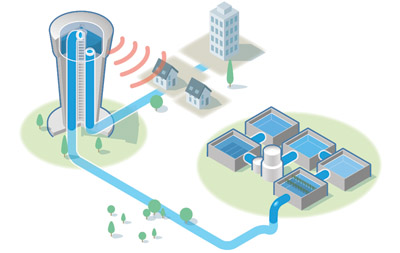Water towers and semi-subterranean tanks can be found throughout the drinking water supply. These raised reservoirs ensure that drinking water is supplied while maintaining a constant pressure to the customers’ taps.
They ensure that there is a water supply based on their capacity. Therefore, even if the pumping and water treatment plants shut down, their capacity allows them to ensure that water is still distributed for several hours or even several days as a result of gravity.
These highly vulnerable sites must comply with all laws and regulations concerning the protection of installations from malicious acts.
Water reservoirs need to be monitored 24/7 as they are mostly isolated without any people on site.
Our telemetry solutions enable operators to make sure everything is secure, manage on-call duty and manage access to the reservoirs. In the event of any unforeseen breaches, the telemetry equipment sends alerts to the main station or to the on-call technician’s computer.
Managing and automating the filling of the reservoir
 The intersite communication function enables two telemetry devices to communicate remotely. The one in the reservoir monitors the water levels using a piezoresistive sensor or float switches. When the level drops below the lower threshold, it remotely activates the pumping via the local station for the plant responsible for supplying the reservoir.
The intersite communication function enables two telemetry devices to communicate remotely. The one in the reservoir monitors the water levels using a piezoresistive sensor or float switches. When the level drops below the lower threshold, it remotely activates the pumping via the local station for the plant responsible for supplying the reservoir.
Depending on how much water is left, the local station can delay the pumping until off-peak hours for electricity.
The telemetry equipment monitors and records the reservoir’s water level. It immediately sends alerts when the level drops too low or if there is an overflow.
If a breach is detected when the reservoir is being filled, the intersite controller can automatically stop the pumping remotely to reduce the amount of water which may need to be disinfected or drained. Similarly, if the reservoir is equipped with an electrically-controlled solenoid valve, the local station can automatically isolate the installation from the rest of the distribution network.
By being able to act automatically and without human intervention, telemetry can optimise and secure the filling process. Through continuous monitoring and M2M communication between the reservoir’s local stations and the pumping station, it is possible to reduce operating costs by limiting the visits for maintenance and inspections.
Other benefits of using telemetry for reservoirs
Monitoring the quality of stored water
Water quality sensors (e.g. pH, conductivity, etc.) can be connected to the telemetry station to continuously monitor the quality of the water being distributed. The telemetry station also manages the chlorine dosing pumps.
Remote reading of meters
In the first level of district metering, the reservoir’s output meter is remotely read by the local station. The indexes provided to the operator include information on the volumes of water distributed. This baseline data will be essential for district metering and leak detection in the network.






